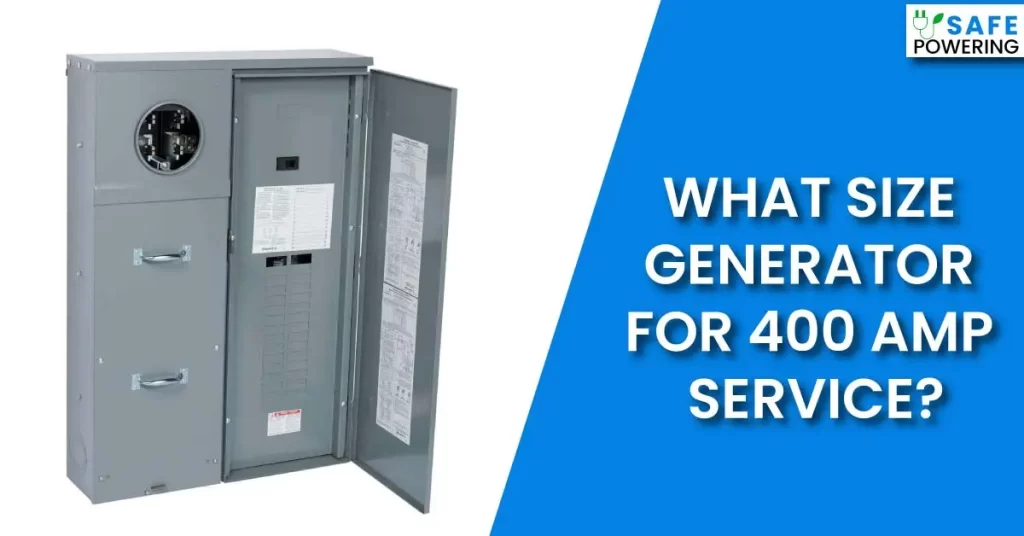What Size Generator For 400 Amp Service for Power Outages?
Don’t let a power outage catch you off guard. Find out “what size generator for 400 amp service” for home, worksite, and commercial use in this article.
Choosing the right size generator for a 400 amp service is crucial for providing consistent power during power outages or emergencies.
A generator that is too small will not be able to handle the load and could potentially cause damage to both the generator and the electrical equipment it is powering.
On the other hand, a generator with high power output can be unnecessary, leading to increased costs in fuel consumption and maintenance.
The appropriate generator size for a 400 amp service depends on the total electrical load, including essential appliances and surge requirements. A 35KW to 50 kW generator is typically sufficient for most 400 amp services. However, if there are additional electrical needs, such as home renovations or new appliances, a larger generator may be required.
When determining the appropriate generator size for a 400 amp service, it is important to consider the total electrical load that the generator will need to support.

What are the Required Watts for a 400 Amp Service?
here are some sample calculations to give you an idea of how the required watts for a 400-amp service can be calculated:
1. Calculation Based on Total Amperage:
To calculate the total watts for a 400 amp service, we can use the following formula:
Total watts = Total amperage x Voltage
Assuming a standard voltage of 120 volts, the total watts for a 400 amp service would be:
Total watts = 400 amps x 120 volts = 48,000 watts
However, this calculation does not consider the electrical demand of individual appliances or devices. To get a more accurate calculation, a load calculation must be performed.
2. Calculation Based on Load:
A load calculation considers the electrical demand of each appliance and device in the building or home, as well as any surge requirements during startup.
To calculate the required watts based on a load calculation, the following formula can be used:
Required watts = Total demand load x Safety factor
The safety factor is typically 25% to account for any additional surge requirements during startup.
For example, if the load calculation shows a total demand load of 70,000 watts, the required watts for a 400-amp service with a 25% safety factor would be:
Required watts = 70,000 watts x 1.25 = 87,500 watts
It is important to note that these calculations are for illustrative purposes only, and actual calculations may vary widely based on the specific electrical demand of the building or home.
How to Size a Generator for 400 Amp Service?
Sizing a generator for a 400-amp service requires a detailed assessment of the electrical load that the generator will be expected to support.
This assessment involves calculating the wattage requirements of all the electrical devices that will be connected to the generator, and factoring in the starting wattage of any devices with electric motors.
It is essential to ensure that the generator’s power output is enough to handle the highest possible demand from the electrical system.
For a 400-amp service, a generator with a power output of at least 35kW or higher is typically recommended.
However, it is crucial to note that this is a general guideline, and the actual power requirements will depend on the specific electrical load of the system.
Suppose we have a residential property with a 400 amp service and the following electrical devices:
| Appliance | Starting Wattage | Rated Wattage |
| Air Conditioner | 1500-3500 | 600-1500 |
| Refrigerator | 1200-2200 | 600-800 |
| Freezer | 1200-2200 | 500-800 |
| Water Heater | 3500-5500 | 3000-4500 |
| Oven | 3000-5000 | 2400-3600 |
| Stove | 3000-5000 | 2400-3600 |
| Microwave | 1000-1500 | 600-1200 |
| Dishwasher | 1300-2200 | 1200-1500 |
| Washing Machine | 1200-2000 | 800-1200 |
| Dryer | 5000-6000 | 4000-5000 |
| Sump Pump | 800-1200 | 400-800 |
| Electric Heater | 1500-2000 | 1200-1500 |
| Television | 150-300 | 100-150 |
| Computer | 800-1200 | 200-500 |
| Lights (per bulb) | 40-100 | 5-60 |
Recommended Read: What size generator do I need for a 100 amp service?
To calculate the total electrical load, we need to add up the starting watts and rated watts of all the devices.
In this case, the total starting wattage is:
3,500 + 1,200 + 1,200 + 5,500 + 5,000 + 5,000 + 1,500 + 2,200 + 2,000 + 6,000 + 1,200 + 2,000 + 300 + 1,200 + (100 x number of bulbs)
Suppose there are 20 light bulbs in the property, so the total starting wattage for the lights is:
100 x 20 = 2,000 watts
Therefore, the total starting wattage for all the devices is:
3,500 + 1,200 + 1,200 + 5,500 + 5,000 + 5,000 + 1,500 + 2,200 + 2,000 + 6,000 + 1,200 + 2,000 + 300 + 1,200 + 2,000 = 39,900 watts
To determine the generator size required, we need to factor in the starting wattage of the devices.
A general rule of thumb is to add 30% to the total starting wattage to account for the surge in power demand. Therefore, the minimum generator size required is:
39,900 x 1.3 = 51,870 watts, or approximately 52 kW
What are the Best Generators for 400 Amp Service?
| Generator Model | Power Output | Fuel Type | Noise Level | Features |
| Generac 7043 Guardian Series | 22 kW | Natural Gas or Liquid Propane | 66 dBa | Wi-Fi enabled, mobile link remote monitoring, 5-year limited warranty |
| Cummins RS36 QuietConnect Series | 36 kW | Natural Gas or Liquid Propane | 68 dBa | Weather-resistant enclosure, remote monitoring, 5-year limited warranty |
| Kohler 38RCL | 38 kW | Natural Gas or Liquid Propane | 65 dBa | Corrosion-resistant enclosure, 5-year/2000-hour warranty, compatible with Kohler’s OnCue Plus and OnCue Basic remote monitoring systems |
| Briggs & Stratton 076161 | 45 kW | Liquid Propane or Natural Gas | 71 dBa | Corrosion-resistant enclosure, 4-year limited warranty, Symphony II Power Management system |
| Generac 7039 Guardian Series | 48 kW | Natural Gas or Liquid Propane | 70 dBa | Wi-Fi enabled, mobile link remote monitoring, 5-year limited warranty |
| Cummins RS60 QuietConnect Series | 60 kW | Natural Gas or Liquid Propane | 68 dBa | Weather-resistant enclosure, remote monitoring, 5-year limited warranty |
| Kohler 80REZGD | 80 kW | Natural Gas or Liquid Propane | 67 dBa | Corrosion-resistant enclosure, 5-year/2000-hour warranty, compatible with Kohler’s OnCue Plus and OnCue Basic remote monitoring systems |
| Generac 7037 Guardian Series | 80 kW | Natural Gas or Liquid Propane | 70 dBa | Wi-Fi enabled, mobile link remote monitoring, 5-year limited warranty |
| Cummins RS125 QuietConnect Series | 125 kW | Natural Gas or Liquid Propane | 70 dBa | Weather-resistant enclosure, remote monitoring, 5-year limited warranty |
| Kohler 150REZGC | 150 kW | Natural Gas or Liquid Propane | 69 dBa | Corrosion-resistant enclosure, 5-year/2000-hour warranty, compatible with Kohler’s OnCue Plus and OnCue Basic remote monitoring systems |
Recommended Read: What size generator do I need for a 200 amp service?
Frequently Asked Questions (FAQs)
What is The Difference Between Starting Watts and Rated Watts?
Starting wattage is the maximum amount of power an appliance needs to start up, while rated wattage is the amount of power an appliance needs to run continuously once it has started.
How do I determine the wattage of an appliance?
Check the energy labeling or manual of the appliance, which should indicate the wattage or amperage rating. If it is not listed, you can use a watt meter to measure the appliance’s power consumption.
How do I Size a Generator for My Home?
To size a generator for your home, add up the wattage of all the appliances and devices you want to power, including their starting and running wattages. Choose a generator that can handle the total wattage plus some additional capacity for unexpected power needs.
What Size Generator for 400 Amp Service?
The size of the generator needed for a 400 amp service will depend on the total wattage of the appliances and devices that need to be powered. A 400 amp service can support a large number of appliances and devices, so a generator with a high wattage capacity, such as 35kW or above, may be needed.

Fareed, the highly skilled electrical expert, boasts 5 years of extensive experience in proficiently maintaining, repairing, diagnosing, and installing a diverse range of electrical systems.
